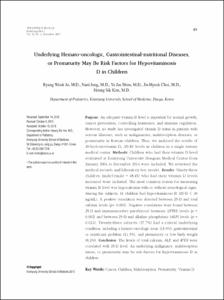Underlying Hemato-oncologic, Gastrointestinal-nutritional Diseases, or Prematurity May Be Risk Factors for Hypovitaminosi D in Children
- Keimyung Author(s)
- Shim, Ye Jee; Choi, Jin Hyeok; Kim, Heung Sik
- Department
- Dept. of Pediatrics (소아청소년학)
- Journal Title
- Keimyung Medical Journal
- Issued Date
- 2015
- Volume
- 34
- Issue
- 2
- Keyword
- Cancer; Children; Malabsorption; Prematurity; Vitamin D
- Abstract
- Purpose: An adequate vitamin D level is important for normal growth,
cancer prevention, controlling hormones, and immune regulation.
However, no study has investigated vitamin D status in patients with
serious illnesses, such as malignancies, malabsorption diseases, or
prematurity in Korean children. Thus, we analyzed the results of
25-hydroxyvitamin D3 (25-D) levels in children in a single tertiary
medical center. Methods: Children who had their vitamin D level
evaluated at Keimyung University Dongsan Medical Center from
January 2004 to December 2014 were included. We reviewed the
medical records and laboratory test results. Results: Ninety-three
children (male:female = 48:45) who had their vitamin D levels
measured were included. The most common reason for measuring
vitamin D level was hypocalcemia with or without neurological signs.
Among the subjects, 61 children had hypovitaminosis D (25-D < 30
ng/mL). A positive correlation was detected between 25-D and total
calcium levels (p = 0.001). Negative correlations were found between
25-D and immunoreactive parathyroid hormone (iPTH) levels (p =
0.002) and between 25-D and alkaline phosphatase (ALP) levels (p =
0.021). Twenty-three subjects (37.7%) had a critical underlying
condition, including a hemato-oncologic issue (18.0%), gastrointestinal
or nutritional problem (11.5%), and prematurity or low birth weight
(8.2%). Conclusion: The levels of total calcium, ALP, and iPTH were
correlated with 25-D level. An underlying malignancy, malabsorption
issues, or prematurity may be risk factors for hypovitaminosis D in
children.
- Alternative Title
- Underlying Hemato-oncologic, Gastrointestinal-nutritional
Diseases, or Prematurity May Be Risk Factors for Hypovitaminosi
D in Children
- Publisher
- Keimyung University School of Medicine
- Citation
- Byung Wook Jo et al. (2015). Underlying Hemato-oncologic, Gastrointestinal-nutritional
Diseases, or Prematurity May Be Risk Factors for Hypovitaminosi
D in Children. Keimyung Medical Journal, 34(2), 89–97.
- Type
- Article
- Appears in Collections:
- 2. Keimyung Medical Journal (계명의대 학술지) > 2015
1. School of Medicine (의과대학) > Dept. of Pediatrics (소아청소년학)
Items in Repository are protected by copyright, with all rights reserved, unless otherwise indicated.
